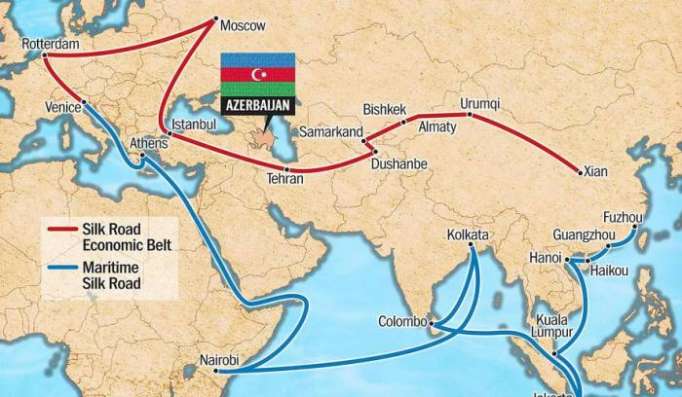It is a tolerant, secular majority Muslim country of about 10 million people. Azerbaijan borders Russia on the north and Iran on the south. In light of Russia’s expanding relationship with Iran, the world’s leading state sponsor of terrorism, Azerbaijan’s independence and sovereignty are invaluable to American interests.
We should never forget that after the Sept. 11, 2001 terrorists’ attacks, President Heydar Aliyev reached out to the United States and pledged his full support. Azerbaijan was also among the first countries to commit ground troops to the NATO-led military operations in Afghanistan, as well as lending its strategic location to overflights and other logistical cooperation.
With its fine balancing of foreign policy toward the world’s major powers, Azerbaijan neither aspires to join NATO nor the Russian-led Collective Security Treaty Organization. Nonetheless, an independent Azerbaijan is an obstacle to Russian President Vladimir Putin’s goal of reconstituting the former Soviet controlled areas under Moscow’s domination
Partnership with Georgia and Turkey — with strong Western support and participation in building the strategic Baku-Tbilisi-Ceyhan (BTC) oil and the Baku-Tbilisi-Erzurum (BTE) gas pipelines has been critical in weakening Moscow’s energy blackmail stranglehold on Europe.
Not to be overlooked is China’s expansion into the region. The Baku-Beijing relation as it relates to China’s growing interest in the South Caucasus is a prime example. Strategically, China’s Belt and Road Initiative (BRI) is their roadmap for geopolitical dominance. It is soft power with an underlying hard power, military component the so-called “String of Pearls” bases and facilities.
Recently, the South Caucasus has become an area of great interest as an extension of China’s “Silk Road” project which has as its objective to connect Europe and East Asia via a new road network and railroad across the Eurasian landmass. China’s real connection with the region will come when the recently inaugurated Azerbaijan Baku-Tbilisi-Kars (BKT) railroad reaches its full operational capacity .
There is no question the Caucasus and Azerbaijan in particular, hold great geostrategic importance as a transit corridor for global resources such as oil and natural gas, as well as the intersection of important transportation routes between all areas. U.S. and Azerbaijan relations continue to grow, but there are efforts to disrupt this partnership.
These largely come from Azerbaijan’s neighbor Armenia and America’s large and influential Armenian lobby. Let’s face facts, Armenia has not been able to escape from Russia’s de facto control. A key weapon in the disinformation campaign to impede U.S.-Azerbaijan relations is the tragic event that happened 30 years ago in Sumgayit, February 1988.
Twenty six to 29 ethnic Armenians out of a population of 14,000 Armenians were killed (Armenian sources place the number much higher). Clearly, this was not ethnic genocide or a massacre. The disinformation campaign has been to associate these deaths with the memories of the 1915 Armenian “genocide” by the Ottoman Empire during World War I and to erroneously associate that tragic event in the American psyche with Azerbaijan.
Contrary to this disinformation campaign, we now know that one of the most hard-core groups that attacked the Armenians was led by an ethnic Armenian named Eduard Grigoryan, who was later sent to prison for his role.
By the same token, another tragic incident from around the same time, but much larger and graver in scale and purpose, has been thrown down the memory hole. That’s the ethnic massacre — a real one — in the town of Khojaly.
Khojaly was a small Azerbaijani-populated town in Nagorno-Karabakh, a region legally part of Azerbaijan but illegally occupied by Armenia since 1992.
In the chaos surrounding the dissolution of the USSR in December 1991, Armenian nationalist forces saw their opportunity to tear Nagorno-Karabakh away from Azerbaijan and join it to Armenia. Unfortunately, this also meant the ethnic cleansing of all Azerbaijanis from the coveted territory. Khojaly, population 7,000, mostly Azerbaijanis, was in the way.
On the night of Feb. 25-26, 1992, Armenian forces subjected Khojaly to heavy bombardment. Civilians seeking to flee were ambushed and shot. Over 600 were killed and many more wounded, including women, children and the elderly.
In contrast to Sumgayit, which was not of an ethnic nature per se, the Khojaly massacre was planned by the Armenian leadership and was aimed at eliminating people on ethnic grounds. In a word, an act of genocide.
The true story of Sumgayit and Khojaly has been difficult to get out due to a very effective Armenian lobby, both in the U.S. and Europe which has cast a cloud over U.S.-Azerbaijan relations. This disinformation campaign must be exposed to prevent any further deterioration of U.S.Azerbaijan relations.
James A. Lyons, a retired U.S. Navy admiral, was commander in chief of the U.S. Pacific Fleet and senior U.S. military representative to the United Nations.
The original article was published in the Washington Post.
More about: Azerbaijan
















































